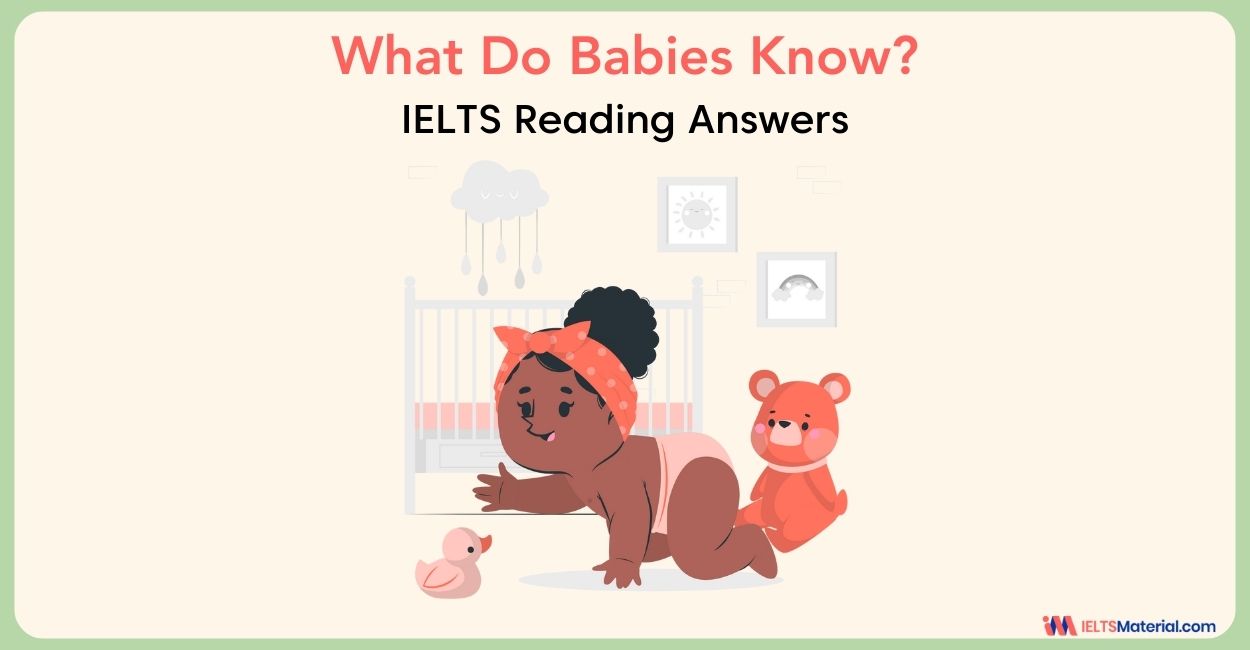What Do Babies Know? IELTS Reading Answers
3 min read
Updated On
-
Copy link
Buckle up to begin your exam preparations with our expert tricks based on the question types and score a band 9 with this “What Do Babies Know? IELTS Reading Answers” topic! And check the answer explanations and locations!
Table of Contents

Limited-Time Offer : Access a FREE 10-Day IELTS Study Plan!
What Do Babies Know? IELTS Reading test passage has appeared in a previous IELTS Exam paper.
With diligent practice, the Reading Module can be the top-scoring category for IELTS Aspirants. To score well, you must understand how to approach and answer the different question types in the Reading Module.
By solving and reviewing Sample Reading Questions from past IELTS papers, you can ensure that your Reading skills are up to the mark. Take the practice test What Do Babies Know? below and try more IELTS reading practice tests from IELTSMaterial.com.
Not sure how to answer Matching Sentence Endings? Take a look at IELTS Reading Matching Sentence Endings – Tips and Sample Practice!
What Do Babies Know? IELTS Reading Passage
You should spend about 20 minutes on Questions 27-40, which are based on the Reading Passage below.
Find the practice test with the What Do Babies Know? PDF here.
What Do Babies Know? IELTS Reading Answers
| Question number | Answer | Keywords | Location of keywords |
|---|---|---|---|
| 27 | TRUE | He sucks his fingers for comfort, but, finding no solace, his mouth crumples, his body stiffens, and he lets rip an almighty shriek of distress. This is the usual expression when babies are left alone or abandoned. | Paragraph A;
Lines 4 – 5 |
| 28 | NOT GIVEN | – | – |
| 29 | FALSE | Though the facility is just 18 months old and has tested only 100 infants, it’s already challenging current thinking on what babies know and how they come to know it. | Paragraph B;
Last line |
| 30 | NOT GIVEN | – | – |
| 31 | TRUE | Baby lab director Sylvain Sirois has been putting these smart-baby theories through a rigorous set of tests. His conclusions so far tend to be more Piagetian: “Babies,” he says, “know nothing.” | Paragraph D;
Last line |
| 32 | FALSE | The mistake of previous research, says Sirois, has been to leap to the conclusion that infants can understand the concept of impossibility from the mere fact that they are able to perceive some novelty in it.
NOTE: Flaw is only in their conclusion. |
Paragraph F;
Line 6 |
| 33 | B | Piaget’s work led him to conclude that infants younger than 9 months have no innate knowledge of how the world works or any sense of “object permanence” (that people and things still exist even when they’re not seen). | Paragraph D;
Line 2 |
| 34 | E | Instead, babies must gradually construct this knowledge from experience. | Paragraph D;
Line 3 |
| 35 | A | Over the past 20 years or so they have been largely set aside by a new generation of “nativist” psychologists and cognitive scientists whose more sophisticated experiments led them to theorise that infants arrive already equipped with some knowledge of the physical world and even rudimentary programming for math and language. | Paragraph D;
Line 4 |
| 36 | D | His own experiments indicate that a baby’s fascination with physically impossible events merely reflects a response to stimuli that are novel. | Paragraph F;
Line 3 |
| 37 | C | In other words, when Daniel had seen the red train come out of the tunnel green a few times, he gets as bored as when it stays the same colour. | Paragraph F;
Line 5 |
| 38 | B | A hidden device above the screen is tracking Daniel’s eyes as they follow the train and measuring the diametre of his pupils 50 times a second. As the child gets bored—or “habituated”, as psychologists call the process— his attention level steadily drops. | Paragraph C;
Lines 2 – 3 |
| 39 | A | Piaget’s “constructivist” theories were massively influential on postwar educators and psychologist, but over the past 20 years or so they have been largely set aside by a new generation of “nativist” psychologists and cognitive scientists | Paragraph D;
Line 4 |
| 40 | D | Data from the eye tracker and the measurement of the pupils (which widen in response to arousal or interest) show that impossible events involving familiar objects are no more interesting than possible events involving novel objects. | Paragraph F;
Line 4 |
Want to improve your IELTS Academic Reading score?
Great work on attempting to solve the What Do Babies Know? IELTS Reading passage! To crack your IELTS Reading in the first go, try solving more of the Recent IELTS Reading Passages.
Check More IELTS Reading Answers
Also check :
Practice IELTS Reading based on question types

Start Preparing for IELTS: Get Your 10-Day Study Plan Today!
Recent Articles

Nehasri Ravishenbagam

Haniya Yashfeen

Haniya Yashfeen

Haniya Yashfeen




Post your Comments